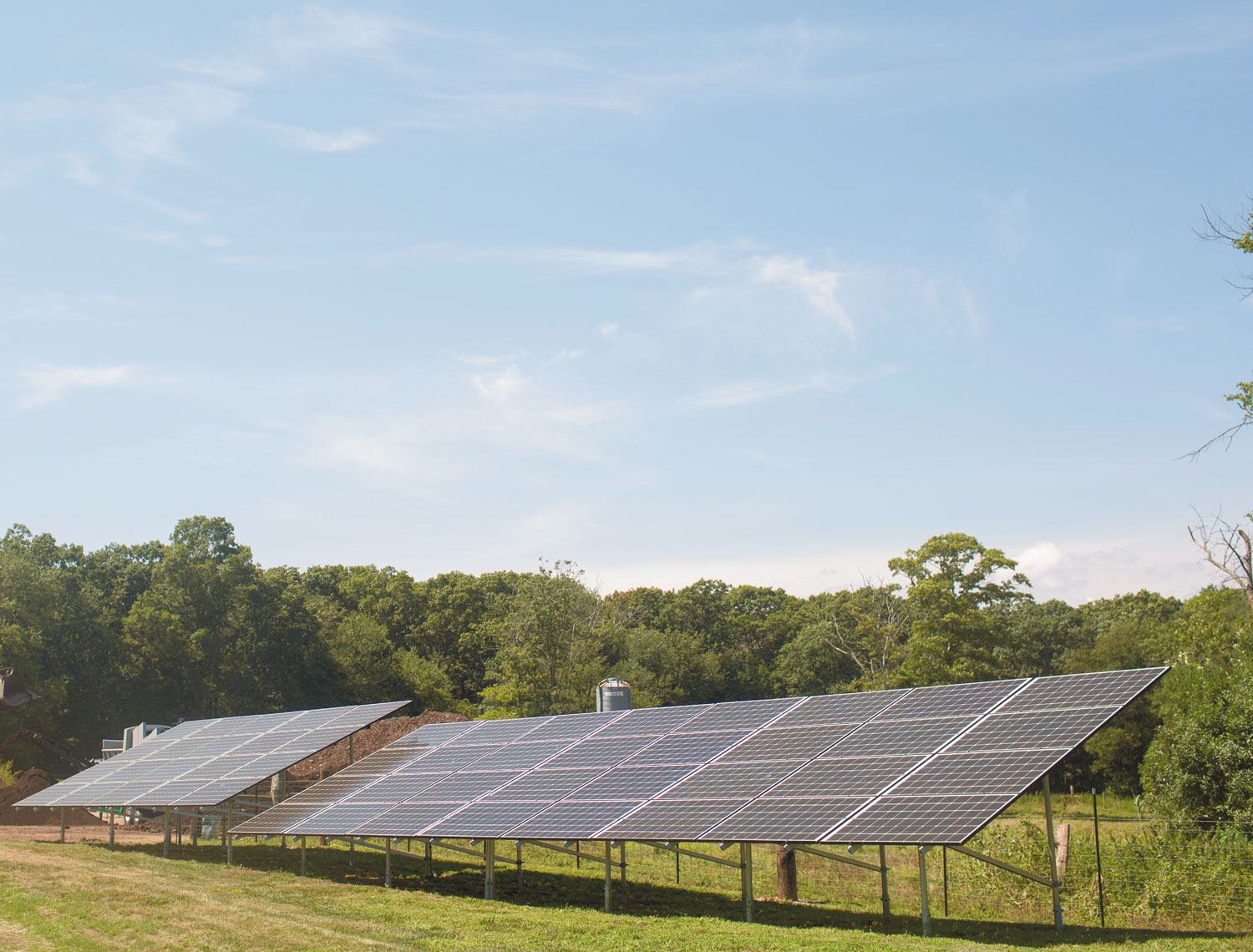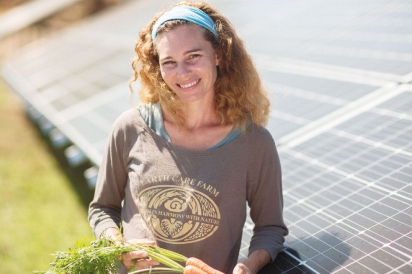Greening the Farm
Rhode Island Steps Ahead to Cleaner Energy for Local Ag
As any farmer will tell you, the sun is the basis of all food production. In fact, it is the primary source of vitality for the entire farm. Through photosynthesis, plants utilize the energy of the sun to synthesize food from carbon dioxide and water. Nutritional elements gathered from the soil create sustenance for plants and other life forms. This fundamental axiom has made life on our planet possible for millennia.
By eating plants, animals and livestock further convert plant matter into protein. Up until just over a century ago, animals, fortified by vegetation, also provided the power required to plow fields, to move harvest to market and to provide basic transportation.
The sun also heats the Earth, albeit unevenly. The uneven heating causes air currents that have also been harvested by way of windmills to simplify farm-related undertakings, such as pumping water and milling grain. When the Industrial Age came to agriculture, the energy game changed. Fossil fuels began to be used to power farm machinery, and even the most remote farms became attached to the electric grid, also powered by fossil fuels.
Now, thanks to the Rhode Island Farm Energy Program (RIFEP), a multi-agency program that helps fund green energy on Rhode Island farms, the pendulum is beginning to swing back the other way.
“It’s a process,” says Josh Goodwin of Goodwin Brothers Farm—a multi-generational family-owned and -operated farm stand in North Smithfield. “The back side of this building is perfect for solar energy, so when we heard about the program, we went for it.”
While Goodwin makes it sound easy, there is a competitive grant process with a project cap of $20,000. Numerous agencies are involved: the Rhode Island Resource Conservation and Development Council Inc.; the state Department of Environmental Management (DEM); the Division of Agriculture and Office of Air Resources; and the Rhode Island Office of Energy Resources.
“There is a lot to it—a lot of different players,” says John Holscher from the Good Earth Organic Farm & Gardening Center in Hope. “But everyone involved was very helpful, and we got through it.”
The DEM works in multiple ways to support Rhode Island’s green economy. The Farm Energy Program seeks to assist local farmers in meeting their energy needs by way of sustainable means and energy efficiencies. Rhode Island is one of only a few states where the number of farms is on the rise. There are more than 1,200 scattered across the state, which represents an increase of 44% since 2002.
“I am thrilled to announce these awards, which are a win for our environment, and for our farmers,” says DEM Director Janet Coit. “What an excellent example of the role each of us can play in strengthening our climate resistance, and promoting healthier communities. Rhode Island is charting a bold course in clean energy, which is exciting and vital. We must continue to invest in our green economy for the benefit of our state, our environment and our families,” says Coit.
At Goodwin Brothers, the energy needs of the display coolers, the two walk-in storage coolers and the greenhouse furnaces will be offset by a 10.54 kilowatt roof-mount solar photovoltaic system. At 8.64 kilowatts, Good Earth has a smaller roof-mount setup, but that energy “will significantly reduce our draw from the grid,” says Holscher.
One of the larger funded projects to date is the $17,000 installation of a 39 kilowatt roof-mount solar photovoltaic system that will offset power used by agricultural operations and storage coolers at Barden Family Orchard in North Scituate.
“Farmers are in a great position to take advantage of recent advancements in solar technology,” said State Energy Commissioner Carol Grant. “Solar panels have become cheaper and more powerful with shorter payback periods, allowing farmers to offset more of the energy they use for their operations and save money in the long term. It is good for their business, and our environment.”
Last year $52,245 was awarded under the RIFEP’s initial grant round: The awards supported energy and energy efficiency projects at Harmony Hill Farm in Glocester, Pat’s Pastured in East Greenwich and Red Planet Vegetable Farm in Johnston. While small when compared to the larger picture of the state’s overall green industries (which account for more than 15,000 jobs and $2.5 billion in economic contributions), the Farm Energy Program is just getting started.
With an increasing number of farms, and a desire by all to lower operating costs by taking advantage of grant money that will provide years of clean renewable energy, one might ask: “How will all of this be paid for?” Good question.
Funding for the RIFEP comes from a much wider source that is based upon the cap-and-trade principle, including the Regional Greenhouse Gas Initiative (RGGI), the first mandatory market-based program in the United States to reduce greenhouse gas emissions. Founded in 2009, RGGI is a cooperative effort among the states of Connecticut, Delaware, Maine, Maryland, Massachusetts, New Hampshire, New York, Rhode Island and Vermont to cap and reduce carbon dioxide emissions from the power sector. The states sell nearly all emission allowances through auctions and invest the proceeds in energy efficiency, renewable energy and other consumer benefit programs. The programs are prompting innovation in the clean energy sector while creating jobs in the RGGI states.
Also involved is Commerce RI, with such programs as the Renewable Energy Fund (REF) and Solarize Rhode Island.
While the process might appear daunting, Rhode Island is fortunate to have an avenue that leads towards energy independence for the state’s fresh food producers. An average of 202 sunny days means that the chances of clear, bright sunshine for solar-powered electrical generation are better than 50%—not that clear skies are required. Depending upon the size and type of the solar array, all that is necessary to make electricity is diffuse light. Clouds and fog can reduce generation capacity by as much as 10 to 25% but, in general, if there is daylight, electricity will flow.
Wind energy has long been a part of the farming landscape. No longer beholden to barge loads of diesel fuel for combustion by noisy, smelly, electric generators, those living on Block Island are now able to enjoy clean renewable energy that is provided by Deepwater Wind. While this scale of project is impractical for a small farm to manage, the concept of mixed use farming where vegetation shares the field with commercially owned wind turbines has broad precedent in the midwestern and western U.S. and abroad. Compact wind turbines are an option for small farms, but the return on investment generally cannot compete with solar.
At Earth Care Farm in Charlestown, rooftop solar is not a consideration, because there is space enough for a stand-alone solar array that is sufficient to power 100% of the rather substantial energy needs for the farm.
“We are excited that we have the ability to continue to add panels onto our existing system. This way we are not only creating a sustainable farm for the present, but also into the future,” says Jayne Merner Senecal, manager of Earth Care Farm. As one of the region’s largest producers of wholesome compost, Earth Care looks forward to using solar energy to operate the machinery that sifts and bags their unique product.
The future looks green for local ag with the increased use of renewable energy on farms around the state. The power and energy of the sun rules our celestial hierarchy while human ingenuity charts a course towards a sustainable future.






